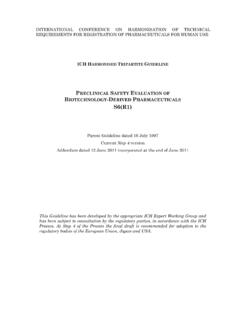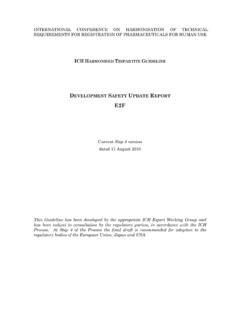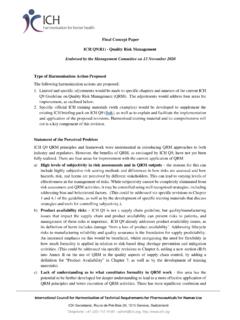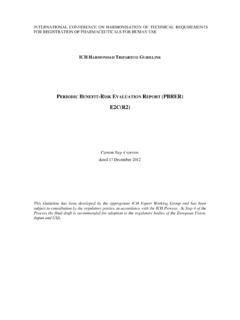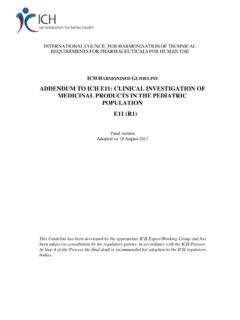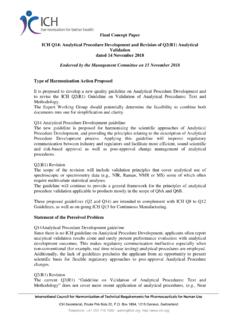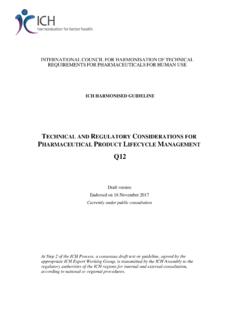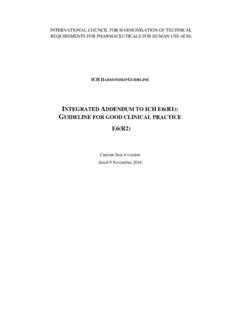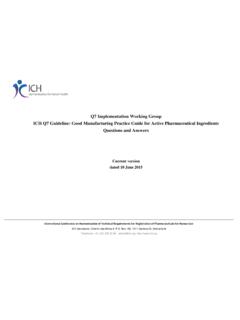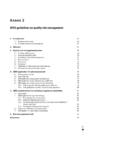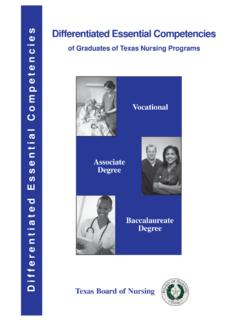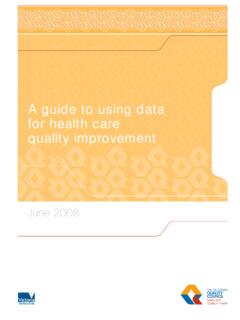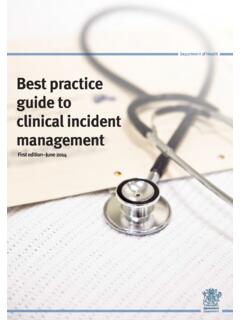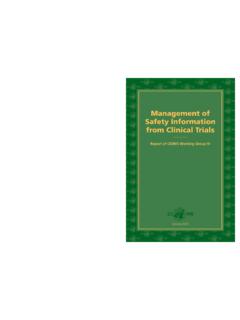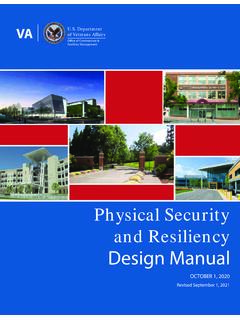Transcription of IMPURITIES GUIDELINE FOR RESIDUAL S Q3C(R8) - ICH
1 INTERNATIONAL COUNCIL FOR HARMONISATION OF TECHNICAL REQUIREMENTS FOR PHARMACEUTICALS FOR HUMAN USE ICH HARMONISED GUIDELINE IMPURITIES : GUIDELINE FOR RESIDUAL SOLVENTS Q3C(R8) Current Step 4 version dated 22 April 2021 This GUIDELINE has been developed by the appropriate ICH Expert Working Group and has been subject to consultation by the regulatory parties, in accordance with the ICH Process. At Step 4 of the Process the final draft is recommended for adoption to the regulatory bodies of ICH regions. Q3C(R8) Document History Code History Date Parent GUIDELINE : IMPURITIES : GUIDELINE for RESIDUAL Solvents Q3C Approval by the Steering Committee under Step 2 and release for public consultation. 6 November 1996 Q3C Approval by the Steering Committee under Step 4 and recommendation for adoption to the three ICH regulatory bodies. 17 July 1997 Revision of the PDE information for THF contained in the Parent GUIDELINE Q3C(R1) Note: Prior to adding the revision to the parent GUIDELINE in November 2005, the code was Q3C(M) for THF.
2 Permissible Daily Exposure (PDE) for Tetrahydrofuran (THF): revision of PDE based on new toxicological data. Approval by the Steering Committee of the new PDE for THF under Step 2 and release for public consultation. 20 July 2000 Q3C(R1) Note: Prior to adding the revision to the parent GUIDELINE in November 2005, the code was Q3C(M) for THF. Approval by the Steering Committee under Step 4 and recommendation for adoption to the three ICH regulatory bodies. 12 September 2002 Revision of PDE information for NMP contained in the Parent GUIDELINE Q3C(R2) Note: Prior to adding the revision to the parent GUIDELINE in November 2005, the code was Q3C(M) for NMP. Permissible Daily Exposure (PDE) for N-Methylpyrrolidone (NMP): revision of PDE based on new toxicological data. Approval by the Steering Committee of the Revision under Step 2 and release for public consultation. 20 July 2000 Q3C(R2) Note: Prior to adding the revision to the parent GUIDELINE in November 2005, the code was Q3C(M) for NMP.
3 Approval by the Steering Committee under Step 4 and recommendation for adoption to the three ICH regulatory bodies. 12 September 2002 Q3C(R3) Note: Prior to adding the corrigendum to the parent GUIDELINE in November 2005, the code was Q3C(M) for NMP. Corrigendum to calculation formula approved by the Steering Committee. 28 October 2002 Q3C(R3) The parent GUIDELINE is now renamed Q3C(R3) as the two updates (PDE for N-Methylpyrrolidone and PDE for Tetrahydrofuran) and the corrigendum of the update for NMP have been added to the parent GUIDELINE . November 2005 Parent GUIDELINE : IMPURITIES : GUIDELINE for RESIDUAL Solvents Q3C(R4) Update of Table 2, Table 3 and Appendix 1 to reflect the revision of the PDEs for N-Methylpyrrolidone and Tetrahydrofuran. February 2009 Revision of PDE information for Cumene contained in the Parent GUIDELINE Q3C(R5) Permissible Daily Exposure (PDE) for Cumene: revision of PDE based on new toxicological data.
4 Approval by the Steering Committee under Step 2 and release for public consultation. 26 March 2010 Q3C(R5) Approval of the PDE for Cumene by the Steering Committee under Step 4 and recommendation for adoption to the three ICH regulatory bodies. The PDE for Cumene document has been integrated as part IV in the core Q3C(R4) GUIDELINE which was then renamed Q3C(R5). The Table 2, Table 3 and Appendix 1 have been updated to reflect the revision of the PDE for Cumene. 4 February 2011 Revision of PDE information for Methylisobutylketone contained in the Parent GUIDELINE and to include a PDE for Triethylamine Q3C(R6) Permissible Daily Exposure (PDE) for Triethylamine and Methylisobutylketone: revision of PDE based on new toxicological data. Approval by the Assembly under Step 2 and release for public consultation. 9 November 2016 Q3C(R6) Approval of the PDE for Triethylamine and Methylisobutylketone by the Assembly under Step 4 and recommendation for adoption to the three ICH regulatory bodies.
5 The PDE for Triethylamine and Methylisobutylketone document has been integrated as part V in the core Q3C(R5) GUIDELINE which was then renamed Q3C(R6). The Table 2, Table 3 and Appendix 1 have been updated to reflect the revision of the PDE for Triethylamine and Methylisobutylketone. 9 November 2016 Correction of the PDE for Ethyleneglycol Q3C(R7) Correction for the PDE and concentration limit for Ethyleneglycol on Table 2 page 6, as per the correct value calculated in Pharmeuropa, Vol. 9, No. 1, Supplement, April 1997 S36. 15 October 2018 Q3C(R6) Further to archival searches related to the Permissible Daily Exposure (PDE) for ethyleneglycol, the Q3C(R7) GUIDELINE was reverted back to the Q3C(R6) GUIDELINE . Further information is provided in the cover statement dated 22 July 2019. 4 October 2019 Addition of PDE for 2-Methyltetrahydrofuran (2-MTHF), Cyclopentyl Methyl Ether (CPME), and Tertiary Butyl Alcohol (TBA) Q3C(R8) Endorsement of Part VI of Q3C(R8) (PDEs for 2-MTHF, CPME, TBA) by the Members of the ICH Assembly under Step 2 and released for public consultation.
6 25 March 2020 Q3C(R8) Adoption of Part VI of Q3C(R8) (PDEs for 2-MTHF, CPME, TBA) by the Regulatory Members of the ICH Assembly under Step 4 . 22 April 2021 Legal notice: This document is protected by copyright and may, with the exception of the ICH logo, be used, reproduced, incorporated into other works, adapted, modified, translated or distributed under a public license provided that ICH's copyright in the document is acknowledged at all times. In case of any adaption, modification or translation of the document, reasonable steps must be taken to clearly label, demarcate or otherwise identify that changes were made to or based on the original document. Any impression that the adaption, modification or translation of the original document is endorsed or sponsored by the ICH must be avoided. The document is provided "as is" without warranty of any kind. In no event shall the ICH or the authors of the original document be liable for any claim, damages or other liability arising from the use of the document.
7 The above-mentioned permissions do not apply to content supplied by third parties. Therefore, for documents where the copyright vests in a third party, permission for reproduction must be obtained from this copyright holder. 1 IMPURITIES : GUIDELINE FOR RESIDUAL SOLVENTS ICH Harmonised GUIDELINE TABLE OF CONTENTS PART I: 1. INTRODUCTION .. 1 2. SCOPE OF THE GUIDELINE .. 1 3. GENERAL PRINCIPLES .. 2 Classification of RESIDUAL Solvents by Risk Assessment .. 2 Methods for Establishing Exposure Limits .. 2 Options for Describing Limits of Class 2 Solvents .. 3 Analytical Procedures .. 4 Reporting levels of RESIDUAL solvents .. 4 4. LIMITS of RESIDUAL SOLVENTS .. 5 Solvents to Be Avoided .. 5 Solvents to Be Limited .. 6 Solvents with Low Toxic Potential .. 7 Solvents for which No Adequate Toxicological Data was Found .. 9 GLOSSARY .. 10 APPENDIX 1. LIST OF SOLVENTS INCLUDED IN THE GUIDELINE .. 11 APPENDIX 2. ADDITIONAL BACKGROUND .. 16 Environmental Regulation of Organic Volatile Solvents.
8 16 RESIDUAL Solvents in Pharmaceuticals .. 16 APPENDIX 3. METHODS FOR ESTABLISHING EXPOSURE LIMITS .. 17 PART II: PDE for Tetrahydrofuran .. 20 PART III: PDE for N-Methylpyrrolidone (NMP) .. 22 PART IV: PDE for 24 PART V: 2 PDE for Triethylamine and PDE of Methylisobutylketone .. 28 PART VI: PDE for 2-Methyltetrahydrofuran, Cyclopentyl Methyl Ether, and Tertiary-Butyl Alcohol 35 1 PART I: IMPURITIES : GUIDELINE FOR RESIDUAL SOLVENTS Having reached Step 4 of the ICH Process at the ICH Steering Committee meeting on 17 July 1997, this GUIDELINE is recommended for adoption to the three regulatory parties to ICH 1. INTRODUCTION The objective of this GUIDELINE is to recommend acceptable amounts for RESIDUAL solvents in pharmaceuticals for the safety of the patient. The GUIDELINE recommends use of less toxic solvents and describes levels considered to be toxicologically acceptable for some RESIDUAL solvents. RESIDUAL solvents in pharmaceuticals are defined here as organic volatile chemicals that are used or produced in the manufacture of drug substances or excipients, or in the preparation of drug products.
9 The solvents are not completely removed by practical manufacturing techniques. Appropriate selection of the solvent for the synthesis of drug substance may enhance the yield, or determine characteristics such as crystal form, purity, and solubility. Therefore, the solvent may sometimes be a critical parameter in the synthetic process. This GUIDELINE does not address solvents deliberately used as excipients nor does it address solvates. However, the content of solvents in such products should be evaluated and justified. Since there is no therapeutic benefit from RESIDUAL solvents, all RESIDUAL solvents should be removed to the extent possible to meet product specifications, good manufacturing practices, or other quality-based requirements. Drug products should contain no higher levels of RESIDUAL solvents than can be supported by safety data. Some solvents that are known to cause unacceptable toxicities (Class 1, Table 1) should be avoided in the production of drug substances, excipients, or drug products unless their use can be strongly justified in a risk-benefit assessment.
10 Some solvents associated with less severe toxicity (Class 2, Table 2) should be limited in order to protect patients from potential adverse effects. Ideally, less toxic solvents (Class 3, Table 3) should be used where practical. The complete list of solvents included in this GUIDELINE is given in Appendix 1. The lists are not exhaustive and other solvents can be used and later added to the lists. Recommended limits of Class 1 and 2 solvents or classification of solvents may change as new safety data becomes available. Supporting safety data in a marketing application for a new drug product containing a new solvent may be based on concepts in this GUIDELINE or the concept of qualification of IMPURITIES as expressed in the GUIDELINE for drug substance (Q3A, IMPURITIES in New Drug Substances) or drug product (Q3B, IMPURITIES in New Drug Products), or all three guidelines . 2. SCOPE OF THE GUIDELINE RESIDUAL solvents in drug substances, excipients, and in drug products are within the scope of this GUIDELINE .
![[ICH E2F] [EXAMPLE DSUR – PHASE III INVESTIGATIONAL …](/cache/preview/e/7/a/2/e/6/3/0/thumb-e7a2e63043c4463724e748eb98faa3a7.jpg)
